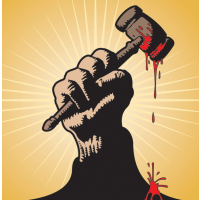California Proposes a One-Drug Solution to Re-Animate the Death Penalty

Death penalty advocates think California is long overdue to execute someone—it’s been almost 10 years and Death Row is overcrowded. The California Department of Corrections and Rehabilitation (CDCR) made a formal proposal (pdf) Friday to break the logjam by recommending a single-drug method of execution.
Various legal challenges have impeded the state’s ongoing efforts to execute prisoners. California switched from the gas chamber to lethal injection in 1996 when it executed serial slayer William Bonin, known as the Freeway Killer. Bonin tortured and killed at least 21 youths and young men. In his last interview, Bonin said his only regret was not pursuing a bowling career.
In December 2006, 11 months after Clarence Ray Allen became the eleventh, and last, man executed in California using drugs, U.S. District Judge Jeremy Fogel, in Morales v. Tilton, shut down California’s administration of lethal injection. He found numerous deficiencies in the drugs used, how they were administered, the awful prison conditions and the generally inept handling of executions. The judge called it a violation of the Eighth Amendment’s prohibition of cruel and unusual punishment.
But Judge Fogel invited the state to keep trying, which it did. Judges continued to apply the death penalty and Death Row grew to 747 prisoners (pdf), including 19 women, while the principal legal impediment to executions―the drug protocol―was debated in the courts.
While Oregon to the north has had a humane drug protocol for legal assisted suicide since 1997, California has wrestled to come up with a multiple-drug concoction to kill prisoners that would meet court standards. The Death Penalty Information Center (DPIC) says that more than 30 states and the federal government use lethal injection as their primary method of carrying out executions.
The CDCR proposed to allow corrections officers a single choice from four barbiturates―amobarbital, pentobarbital, secobarbital or thiopental―as a replacement for the three-drug concoction used to kill Allen. Prisoners could also choose the gas chamber, if they are so disposed. Eight states use the one-drug protocol, according to DPIC, and five others have indicated they are switching to it.
But don’t expect executions in California anytime soon. Law professor Robert Weisberg, co-director of the Stanford Criminal Justice Center, told the Orange County Register, “The lawyers who are going to litigate these things are going to demand Nobel Prize detail on the differences between these drugs, and if there’s any difference, why are we letting a warden make the decision.”
The public will have until January 22 to comment on the CDCR’s proposal. In the meantime, a federal appeals court is pondering the ruling in July 2014 by U.S. District Judge Cormac J. Carney that found California’s entire death penalty process was unconstitutional because of all the delays.
The judge wrote: “For all practical purposes then, a sentence of death in California is a sentence of life imprisonment with the remote possibility of death—a sentence no rational legislature or jury could ever impose.”
The DPIC says 15 prisoners have been executed in other states this year, 13 of them using a single-drug protocol.
–Ken Broder
To Learn More:
Death Penalty to Resume, Officials Propose Plan to Use 1 Drug in Executions (by Don Thompson, Associated Press)
California Proposes New Single-Drug Method for Executions (by Maura Dolan and Paige St. John, Los Angeles Times)
Will California Begin Executions Again Under New Method? (by Christopher Cadelago and Sam Stanton, Sacramento Bee)
California Back on the Slow Path to Resuming Executions (by Ken Broder, AllGov California)
- Top Stories
- Controversies
- Where is the Money Going?
- California and the Nation
- Appointments and Resignations
- Unusual News
- Latest News
- California Forbids U.S. Immigration Agents from Pretending to be Police
- California Lawmakers Urged to Strip “Self-Dealing” Tax Board of Its Duties
- Big Oil’s Grip on California
- Santa Cruz Police See Homeland Security Betrayal in Use of Gang Roundup as Cover for Immigration Raid
- Oil Companies Face Deadline to Stop Polluting California Groundwater





